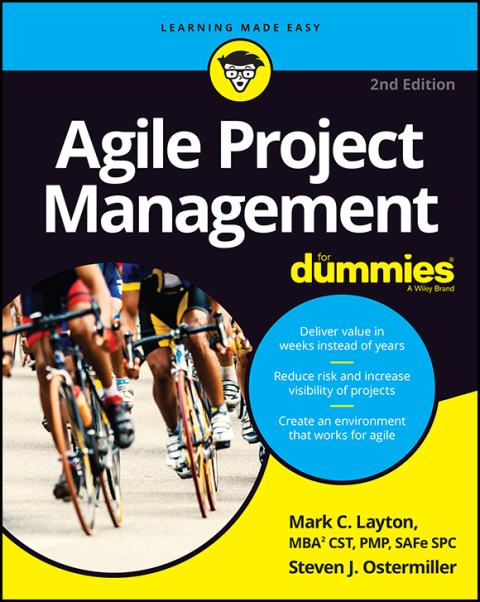Description
Efnisyfirlit
- Cover
- Introduction
- About This Book
- Foolish Assumptions
- Icons Used in This Book
- Beyond the Book
- Where to Go from Here
- Part 1: Understanding Agile
- Chapter 1: Modernizing Project Management
- Project Management Needed a Makeover
- Introducing Agile Project Management
- Chapter 2: Applying the Agile Manifesto and Principles
- Understanding the Agile Manifesto
- Outlining the Four Values of the Agile Manifesto
- Defining the 12 Agile Principles
- Adding the Platinum Principles
- Changes as a Result of Agile Values
- The Agile Litmus Test
- Chapter 3: Why Being Agile Works Better
- Evaluating Agile Benefits
- How Agile Approaches Beat Historical Approaches
- Why People Like Being Agile
- Part 2: Being Agile
- Chapter 4: Agile Approaches
- Diving under the Umbrella of Agile Approaches
- Reviewing the Big Three: Lean, Scrum, and Extreme Programming
- Putting It All Together
- Chapter 5: Agile Environments in Action
- Creating the Physical Environment
- Low-Tech Communicating
- High-Tech Communicating
- Choosing Tools
- Chapter 6: Agile Behaviors in Action
- Establishing Agile Roles
- Establishing New Values
- Changing Team Philosophy
- Part 3: Agile Planning and Execution
- Chapter 7: Defining the Product Vision and Product Roadmap
- Agile Planning
- Defining the Product Vision
- Creating a Product Roadmap
- Completing the Product Backlog
- Chapter 8: Planning Releases and Sprints
- Refining Requirements and Estimates
- Release Planning
- Sprint Planning
- Chapter 9: Working throughout the Day
- Planning Your Day: The Daily Scrum
- Tracking Progress
- Agile Roles in the Sprint
- Creating Shippable Functionality
- The End of the Day
- Chapter 10: Showcasing Work, Inspecting, and Adapting
- The Sprint Review
- The Sprint Retrospective
- Chapter 11: Preparing for Release
- Preparing the Product for Deployment: The Release Sprint
- Preparing for Operational Support
- Preparing the Organization for Product Deployment
- Preparing the Marketplace for Product Deployment
- Part 4: Agile Management
- Chapter 12: Managing Scope and Procurement
- What’s Different about Agile Scope Management?
- Managing Agile Scope
- What’s Different about Agile Procurement?
- Managing Agile Procurement
- Chapter 13: Managing Time and Cost
- What’s Different about Agile Time Management?
- Managing Agile Schedules
- What’s Different about Agile Cost Management?
- Managing Agile Budgets
- Chapter 14: Managing Team Dynamics and Communication
- What’s Different about Agile Team Dynamics?
- Managing Agile Team Dynamics
- What’s Different about Agile Communication?
- Managing Agile Communication
- Chapter 15: Managing Quality and Risk
- What’s Different about Agile Quality?
- Managing Agile Quality
- What’s Different about Agile Risk Management?
- Managing Agile Risk
- Part 5: Ensuring Agile Success
- Chapter 16: Building a Foundation
- Organizational and Individual Commitment
- Choosing the Right Pilot Team Members
- Creating an Environment That Enables Agility
- Support Agility Initially and Over Time
- Chapter 17: Scaling across Agile Teams
- Multi-Team Agile Projects
- Making Work Digestible through Vertical Slicing
- Aligning through Roles with Scrum at Scale
- Multi-Team Coordination with LeSS
- Reducing Dependencies with Nexus
- Joint Program Planning with SAFe
- Modular Structures with Enterprise Scrum
- Chapter 18: Being a Change Agent
- Becoming Agile Requires Change
- Why Change Doesn’t Happen on Its Own
- Strategic Approaches to Implementing and Managing Change
- Platinum Edge’s Change Roadmap
- Avoiding Pitfalls
- Signs Your Changes Are Slipping
- Part 6: The Part of Tens
- Chapter 19: Ten Key Benefits of Agile Project Management
- Better Product Quality
- Higher Customer Satisfaction
- Reduced Risk
- Increased Collaboration and Ownership
- More Relevant Metrics
- Improved Performance Visibility
- Increased Project Control
- Improved Project Predictability
- Customized Team Structures
- Higher Team Morale
- Chapter 20: Ten Key Factors for Project Success
- Dedicated Team Members
- Collocation
- Automated Testing
- Enforced Definition of Done
- Clear Product Vision and Roadmap
- Product Owner Empowerment
- Developer Versatility
- Scrum Master Clout
- Management Support for Learning
- Transition Support
- Chapter 21: Ten Metrics for Agile Organizations
- Return on Investment
- Satisfaction Surveys
- Defects in Production
- Sprint Goal Success Rates
- Time to Market
- Lead and Cycle Times
- Cost of Change
- Team Member Turnover
- Skill Versatility
- Manager-to-Creator Ratio
- Chapter 22: Ten Valuable Resources for Agile Professionals
- Agile Project Management For Dummies Online Cheat Sheet
- Scrum For Dummies
- The Scrum Alliance
- The Agile Alliance
- The Project Management Institute Agile Community
- International Consortium for Agile (ICAgile)
- InfoQ
- Lean Enterprise Institute
- Extreme Programming
- Platinum Edge
- About the Authors
- Connect with Dummies
- End User License Agreement






Reviews
There are no reviews yet.